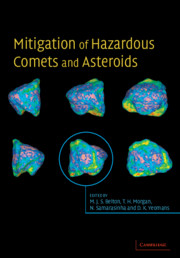Book contents
- Frontmatter
- Contents
- List of contributors
- Preface
- Acknowledgments
- Glossary
- 1 Recent progress in interpreting the nature of the near-Earth object population
- 2 Earth impactors: orbital characteristics and warning times
- 3 The role of radar in predicting and preventing asteroid and comet collisions with Earth
- 4 Interior structures for asteroids and cometary nuclei
- 5 What we know and don't know about surfaces of potentially hazardous small bodies
- 6 About deflecting asteroids and comets
- 7 Scientific requirements for understanding the near-Earth asteroid population
- 8 Physical properties of comets and asteroids inferred from fireball observations
- 9 Mitigation technologies and their requirements
- 10 Peering inside near-Earth objects with radio tomography
- 11 Seismological investigation of asteroid and comet interiors
- 12 Lander and penetrator science for near-Earth object mitigation studies
- 13 Optimal interception and deflection of Earth-approaching asteroids using low-thrust electric propulsion
- 14 Close proximity operations at small bodies: orbiting, hovering, and hopping
- 15 Mission operations in low-gravity regolith and dust
- 16 Impacts and the public: communicating the nature of the impact hazard
- 17 Towards a national program to remove the threat of hazardous NEOs
- Index
2 - Earth impactors: orbital characteristics and warning times
Published online by Cambridge University Press: 12 October 2009
- Frontmatter
- Contents
- List of contributors
- Preface
- Acknowledgments
- Glossary
- 1 Recent progress in interpreting the nature of the near-Earth object population
- 2 Earth impactors: orbital characteristics and warning times
- 3 The role of radar in predicting and preventing asteroid and comet collisions with Earth
- 4 Interior structures for asteroids and cometary nuclei
- 5 What we know and don't know about surfaces of potentially hazardous small bodies
- 6 About deflecting asteroids and comets
- 7 Scientific requirements for understanding the near-Earth asteroid population
- 8 Physical properties of comets and asteroids inferred from fireball observations
- 9 Mitigation technologies and their requirements
- 10 Peering inside near-Earth objects with radio tomography
- 11 Seismological investigation of asteroid and comet interiors
- 12 Lander and penetrator science for near-Earth object mitigation studies
- 13 Optimal interception and deflection of Earth-approaching asteroids using low-thrust electric propulsion
- 14 Close proximity operations at small bodies: orbiting, hovering, and hopping
- 15 Mission operations in low-gravity regolith and dust
- 16 Impacts and the public: communicating the nature of the impact hazard
- 17 Towards a national program to remove the threat of hazardous NEOs
- Index
Summary
Introduction
The most important requirement, scientific or otherwise, for any impact mitigation is the recognition of the hazard, since, in the absence of a perceived impact risk, there is neither the incentive nor the capability to address the threat. Therefore, the success of any potential mitigation effort will rely heavily upon our ability to discover, track, and analyze threatening objects. In this chapter we will consider the effectiveness of the present surveying and monitoring capabilities by bombarding the Earth with a large set of simulated asteroids that is statistically similar to the impacting population.
Our objective is to determine where on the sky impactors may most readily be detected by search instruments and to evaluate current search techniques for their effectiveness at detecting asteroids on impact trajectories. We also consider the likelihood that existing survey efforts would find previously undiscovered impactors with just weeks to months of warning time. We discuss the factors that affect whether an impactor detection is actually recognized as a near-Earth asteroid (NEA) discovery and announced to the community for further analysis, including impact monitoring. We close with an example demonstrating how automatic impact monitoring can detect a distant impending impact immediately after discovery, when the impact probability is very low, and how the threat gradually grows more severe during the discovery apparition. In many cases the threat will not be alarming until the object is re-detected at a subsequent apparition. This can substantially diminish the effective warning time, and hence shorten the time available to mitigate the impact.
Information
- Type
- Chapter
- Information
- Mitigation of Hazardous Comets and Asteroids , pp. 22 - 37Publisher: Cambridge University PressPrint publication year: 2004
Accessibility standard: Unknown
Why this information is here
This section outlines the accessibility features of this content - including support for screen readers, full keyboard navigation and high-contrast display options. This may not be relevant for you.Accessibility Information
- 30
- Cited by
